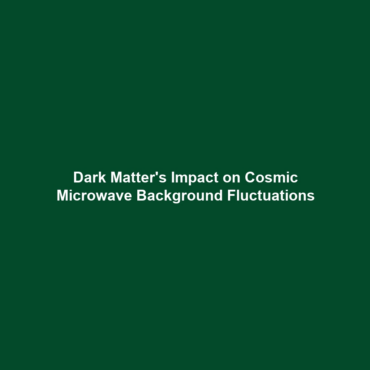What is Dark Matter?
Dark matter is a mysterious and elusive substance that makes up about 27% of the universe. Unlike ordinary matter, which forms stars, planets, and living creatures, dark matter does not emit, absorb, or reflect light, making it virtually invisible and incredibly difficult to study. Its significance lies in its crucial role in the formation and structure of the cosmos, influencing the movement of galaxies and the universe’s overall fate. Understanding dark matter is essential to grasping the broader context of dark matter and dark energy, which collectively shape our universe.
Key Concepts of Dark Matter
To comprehend dark matter, several key concepts should be considered:
1. The Nature of Dark Matter
Dark matter does not interact with electromagnetic forces, which is why it cannot be seen directly. It is inferred through its gravitational effects on visible matter, such as the speed of galaxies and the bending of light from distant objects.
2. Evidence for Dark Matter
Multiple lines of evidence support the existence of dark matter, including:
- Galactic rotation curves that do not align with expected mass distributions.
- Observations of gravitational lensing, where light from distant galaxies is bent by massive objects.
- The Cosmic Microwave Background (CMB), which reflects conditions of the early universe and supports dark matter theories.
3. Dark Matter Candidates
Scientists have proposed various candidates for dark matter, including Weakly Interacting Massive Particles (WIMPs) and axions. The search for these particles remains a key focus in both astrophysics and particle physics.
Applications and Real-World Uses
The understanding of dark matter has several applications, particularly in cosmology and astrophysics:
- Simulation of Cosmic Structures: Researchers use dark matter simulations to model the formation of galaxies and large-scale structures in the universe, informing our understanding of cosmic evolution.
- Technological Advancements: Technologies developed for dark matter detection, such as advanced sensors and data analysis tools, have applications in various fields, including medical imaging and materials research.
Current Challenges in Studying Dark Matter
Despite the progress, several challenges persist in the study of dark matter:
- Detection Issues: Dark matter interacts extremely weakly with normal matter, making it nearly impossible to detect directly.
- Theoretical Uncertainties: There are still unresolved questions about the nature of dark matter, leading to various competing theories.
- Instrument Limitations: Current technology may not be sufficient to observe dark matter particles directly.
Future Research and Innovations
The future of dark matter research holds promise for groundbreaking discoveries:
- Next-Generation Detectors: Researchers are developing more sensitive detectors aimed at identifying dark matter particles.
- Particle Colliders: Advances in particle physics, such as the Large Hadron Collider (LHC), may provide insights into dark matter interactions.
- Astrophysical Missions: Upcoming space missions will further our understanding of cosmic phenomena influenced by dark matter.
Conclusion
In summary, dark matter remains one of the greatest mysteries in astrophysics, impacting our understanding of the universe substantially. Its elusive nature poses unique challenges while revealing fundamental truths about cosmic structure and evolution. Continued research is vital for unlocking the secrets that dark matter holds. For more information, consider exploring additional topics related to dark energy and cosmic phenomena.









